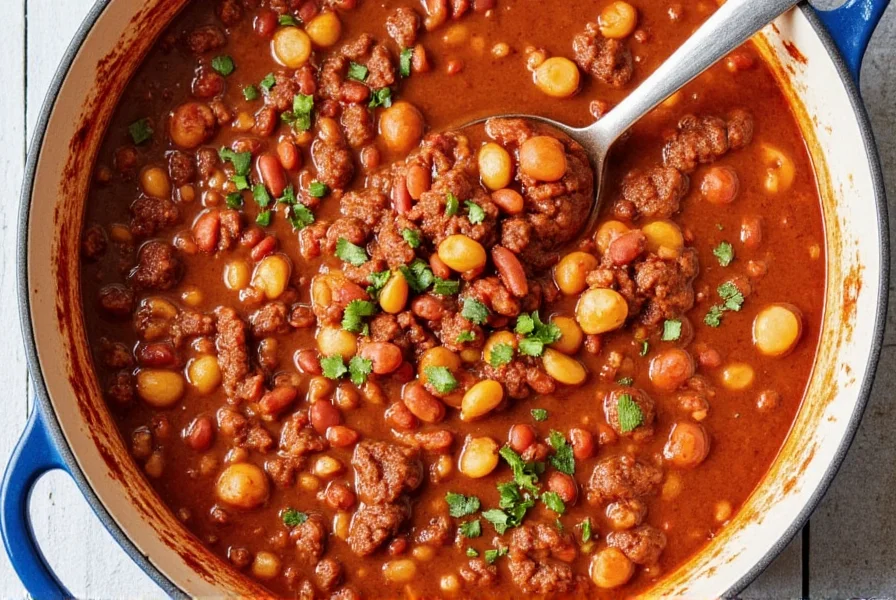Looking for a foolproof beef chili recipe that delivers rich, flavorful results every time? This step-by-step guide provides exact ingredient measurements, clear cooking instructions, and pro tips to master the perfect bowl of chili—whether you're a beginner or seasoned cook. No guesswork needed!
Table of Contents
- Introduction
- Ingredients with Exact Measurements
- Step-by-Step Cooking Instructions
- Spice Layering Secrets
- Serving Suggestions That Impress
- Frequently Asked Questions
- Conclusion
Ingredients with Exact Measurements
Use these precise measurements for consistent, restaurant-quality results:
- Ground Beef – 1.5 lbs (80/20 fat ratio for optimal flavor)
- Yellow Onion – 1 medium (1 cup diced)
- Garlic – 3 cloves, finely minced
- Diced Tomatoes – 1 (28 oz) can, fire-roasted preferred
- Beans – 1 (15 oz) can kidney beans, drained and rinsed
- Chili Powder – 2 tbsp
- Cumin – 1 tbsp
- Paprika – 1 tsp
- Oregano – 1 tsp
- Beef Stock – 1 cup
- Beer – 12 oz (optional, for depth)
- Salt – 1 tsp
- Black Pepper – 1/2 tsp
- Olive Oil – 1 tbsp

Step-by-Step Cooking Instructions
- Brown the Beef – Heat olive oil in a Dutch oven over medium-high heat. Add ground beef and cook for 5-7 minutes, breaking into small pieces until well-browned. Drain excess fat.
- Sauté Aromatics – Add diced onions and minced garlic. Cook for 3 minutes until softened.
- Toast Spices – Stir in chili powder, cumin, paprika, oregano, salt, and pepper. Cook for 1 minute to release flavors.
- Simmer – Add tomatoes, beans, beef stock, and beer (if using). Bring to a boil, then reduce heat to low. Cover and simmer for 1.5-2 hours, stirring occasionally.
- Final Adjustments – Remove lid for the last 15 minutes to thicken. Taste and adjust salt or spices as needed. Add 1 tbsp vinegar or lime juice for brightness.
Spice Layering Secrets
For complex flavor, layer spices at different stages:
- Base Layer (Step 3) – Chili powder, cumin, paprika for foundational heat and smokiness
- Mid-Cooking Boost – Add 1 tsp smoked paprika during simmering for depth
- Finish (Step 5) – Pinch of cayenne or chipotle powder for controlled heat
| Pepper | Scoville Range | Best Use in Chili |
|---|---|---|
| Bell Pepper | 0 SHU | Finely diced for sweetness without heat |
| Jalapeño | 2,500–8,000 SHU | Seed and finely chop for mild heat |
| Ancho Chile | 1,000–2,000 SHU | Ground into powder for smoky depth |
| Cayenne | 30,000–50,000 SHU | Pinch added at the end for controlled kick |
Serving Suggestions That Impress
- Cheese – Sharp cheddar or cotija crumbles
- Creamy Elements – Sour cream or Greek yogurt
- Crispy Toppings – Crushed tortilla chips or Fritos
- Fresh Herbs – Cilantro or green onions
- Side – Warm cornbread or rice
Frequently Asked Questions
How long should I cook chili for optimal flavor?
For maximum flavor development, simmer uncovered for 1.5-2 hours. The longer it cooks (up to 4 hours on low), the more the flavors meld. If short on time, 30 minutes will work but will lack depth.
Can I make this in a slow cooker?
Yes! After browning meat and sautéing aromatics, transfer to slow cooker. Cook on LOW for 6-8 hours or HIGH for 3-4 hours. Add beer and tomatoes in the last hour to preserve freshness.
Why is my chili too watery?
Simmer uncovered for 15-20 minutes to reduce liquid. For quicker thickening, mix 1 tbsp cornstarch with 2 tbsp cold water and stir into chili until thickened.
How do I fix bland chili?
Add 1 tsp salt at a time, then boost with 1 tbsp tomato paste for richness. A splash of vinegar or 1 tsp sugar can balance flavors. For deeper notes, add 1 tbsp instant coffee or 1 oz dark chocolate.
Conclusion
Mastering beef chili isn't about complexity—it's about precise measurements, proper technique, and layering flavors at the right stages. With this exact recipe, you'll consistently create rich, satisfying chili that impresses every time. Now grab your pot and start cooking—your perfect bowl of chili awaits!










 浙公网安备
33010002000092号
浙公网安备
33010002000092号 浙B2-20120091-4
浙B2-20120091-4